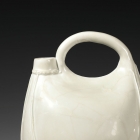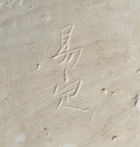J.J. Lally & Co., Oriental Art / New York City, New York
MenuPast Exhibition
EARLY CHINESE WHITE WARES
The Ronald W. Longsdorf Collection
September 11 - October 3, 2015
20.
A BAG-SHAPED FLASK
Liao Dynasty (A.D. 907-1125)
Xing or Ding kilns
following the form of a leather canteen, with swelling sides gathered to a sharp ridge at the top beneath the handle which rises in an elegant arc from the back of the flask to the short upright cylindrical spout embellished with a raised collar and with small knobs imitating rivets, applied with long straight fillets of clay on the narrow front and back and with two more raised fillets applied in long arcs sweeping low on the wide sides, imitating sewn seams, covered with a transparent glaze showing a pale bluish tint where it pools in the recesses, the glaze ending in an uneven line around the border of the unglazed base, the exposed surface of the white porcelain burnt pale tan in the firing, with two characters incised at the center of the base: 易定 (yi ding).
Height 8 7⁄8 inches (22.5 cm)
Only two other early white porcelains similarly inscribed have been previous recorded: two conical bowls said to have been unearthed from the same tomb in the early 20th century. One bowl is now in the Beijing Palace Museum and the other is in the Shanghai Museum. There has been extensive research and scholarly discussion of the correct interpretation of the two-character inscription. Some scholars have suggested that the inscription might refer to Yizhou, a prefecture in Western Central Hebei, but the meaning of the inscription has remained obscure and open to debate. Another scholar working on this question, Lu Minghua, proposed a different interpretation of the inscription, reading the first character as 昜 (yang), and suggesting it should be interpreted as a reference to Quyang, a county in Eastern Hebei where the Ding kilns were located. The argument for this interpretation is presented in full by Lu in “Xingyao ‘Ying’ zi yiji Dingyao ‘Yi ding’ kao” (Verifications of the ‘Ying’ Character on Xing Ware and ‘Yi ding’ on Ding Ware), Shanghai Museum Journal, 1987, No. 4.
More recently, in a paper presented at the symposium on Ding wares organized by the Beijing Palace Museum in 2012, Meng Fanfeng argued that the ‘yi ding’ marks refer to Yizhou and Dingzhou, two prefectures in Hebei province. For the scholarly essay on this subject, see Meng and Huang, “On the Stone Tablet with Inscription for Memorizing Late Buddhist Monk Hengyue of the Tang Dynasty—The Late Tang Ding Kiln was Actually Supervised by Yiwu Army under the Tang Military Governor,” Palace Museum Journal, 2014, No. 2, pp. 39-51, where the authors cite historical records indicating that the ‘yi ding’-marked porcelains were made for “Yi Ding jiedushi,” the commander of the Yiwu Army who administered Yizhou and Dingzhou.
A very similar glazed white porcelain flask excavated from the tomb of Yelü Yuzhi at Chifeng, Inner Mongolia, dated by epitaph to the 4th year of Huitong, Liao dynasty, corresponding to A.D. 941, is illustrated by Zhang (ed.), Zhongguo chutu ciqi quanji (Complete Collection of Ceramic Art Unearthed in China), Vol. 4: Inner Mongolia, Beijing, 2008, p. 18, no. 18. Another similar example, excavated from a Liao dynasty tomb at Hailiban, Fuxin county, Liaoning province, is illustrated by Zhang (ed.), op. cit., Vol. 2: Tianjin, Liaoning, Jiling, Heilongjiang, Beijing, 2008, p. 74, no. 74; and another flask of similar form is illustrated by Lu in Liao dai taoci (Liao Pottery and Porcelain), Shenyang, 2003, p. 146 and on the cover.
Compare also the white porcelain flask of closely related form in the Beijing Palace Museum, with the inscription “Xu Liushi ji” incised on the base, illustrated by Zhao and Zhang (eds.), Qiannian Xingyao (Xing Kiln in its Millennium), Beijing, 2007, p. 155, and illustrated again in Dingci yaji: Gugong bowuyuan zhencang ji chutu Dingyao ciqi huicui (Selection of Ding Ware: the Palace Museum’s Collection and Archaeological Excavation), Beijing, 2012, pp. 30-31, no. 1.
遼 邢窰或定窰「易定」款白瓷提樑雞冠壺 高 22.5 厘米

